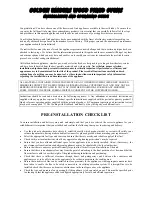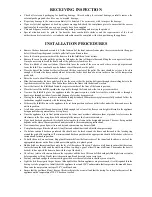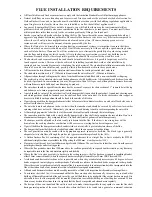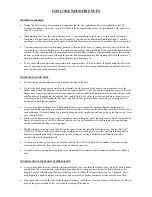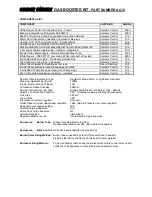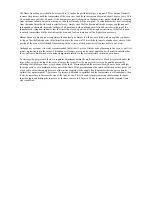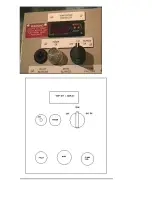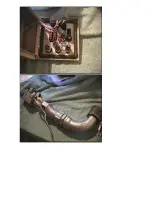
system, it is recommended that a stainless steel baffle element filter be incorporated into the transition flue inlet and that a
break be incorporated into the flue at the point of coupling, effectively creating a miniature range hood.
•
All flame is contained within the oven chamber and has to move out of the chamber at right angles to the induced
convection flow, around a 45mm right-angled protruding lip. Thereafter, all flue gasses must move through the incoming
fresh air stream, effectively inducing a vortex scrubbing effect, mix with an at least equal portion of fresh air, turn at right
angles again and move into the horizontal section of the transition flue, once again change direction at right angles, before
entering the flue shaft. Effectively this means all flue material moves through 320 degrees, around 4 bends, through one
induced vortex and over two differing materials, before it entering the flue shaft. This design is far more effective at
eliminating spark travel than the two horizontal offset strips used in competitive units (which vent directly from the
cooking chamber), and which effectively put the air flue gasses through only two 45 degree bends.
•
Should you wish to add additional filtration, then a twin baffle insert can easily be fitted from galvanised sheet
and riveted into the transition, or, a stainless flame mesh filter can be fabricated to fit into the transition intake
opening. If the flame filter insert is used, it will need to be cleaned extremely regularly so as not to obstruct the
airflow.
•
All flues must be professionally cleaned at least annually
. Where bends or horizontal sections exist in the
flue, or the flue vents into a common duct where fatty deposits may exist, it is recommended that they be
cleaned six monthly and all bends should be fitted with inspection hatches
•
The exact interval between cleaning for each specific system should be determined under advice of a
professional flue cleaner or chimney sweep and will depend on many factors specific to the actual site
and operating conditions and practices
.
•
IMPORTANT! - REFER AT ALL TIMES TO THE CODE APPLICABLE TO THE AUSTRALIAN
STANDARDS FOR SOLID FULE BURNING APPLIANCE FLUES AND INSTALLATION.
THE NATURE OF FIRE
•
Fire is due to a chemical process of oxidation, the combination of a substance with oxygen. Since fire is due to
oxidation, it needs air to burn properly, and a flame will go out after it has used the available oxygen. Almost every
material combines with oxygen given enough time. Iron, for example, will rust and the rust is oxidised iron. When
the chemical combination occurs so rapidly that it is accompanied by a flame, it is called combustion.
•
The Ignition Point, or Kindling Temperature, is the degree of temperature at which a substance will catch fire and
continue to burn. Substances, which can be ignited in the air, are called flammable.
•
The FlashPoint of a flammable item is lower than its ignition point. It is the temperature at which it gives off
sufficient vapour to flash, or flame briefly, in air, but below the temperature at which it can burn continuously or
spontaneously.
•
A fire, once started, will only be self-supporting when the temperature created by the combustion of the burning
substance is as high as or higher than its ignition point. Some hard woods, such as ebony, require a great deal of
heat to burn. If a stick of ebony is placed in a fire, it will burn. When it is removed the fire of the smouldering
ebony itself has a lower temperature than the ignition point and the flames thus die. Fire can burn with or without
flames. Flame indicates that heat has forced gas from a burning substance. The flame is produced by the
combination of this gas with oxygen in the air.
Summary of Contents for Wood Fired Ovens
Page 14: ...GOLDEN EMBERS AC11 CLASS 1 GAS WOOD FIRE GAS TRAIN SCHEMATIC AND LEGEND ...
Page 17: ......
Page 18: ......

